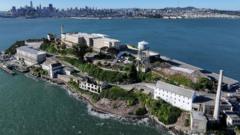President Trump's recent proposal to reopen the now-closed Alcatraz prison has stirred debate regarding its feasibility, historical significance, and potential impact on crime prevention. Experts have voiced skepticism about the plan, citing enormous costs and infrastructural challenges that inhibit any realistic renovation efforts.
Is Trump's Vision for Reopening Alcatraz Feasible or Far-Fetched?

Is Trump's Vision for Reopening Alcatraz Feasible or Far-Fetched?
Analysis of President Trump's proposal to reopen Alcatraz prison as a solution for dangerous criminals, featuring expert opinions on its practicality and implications for historical preservation.
Former U.S. President Donald Trump's controversial proposition to reshape Alcatraz prison into an active correctional facility has ignited discussions around the possibility and practicality of reviving a site known for its infamous past. Located on a rocky island in San Francisco Bay, Alcatraz, once a military fort and later a federal penitentiary, has held the ghosts of notorious criminals like Al Capone and George "Machine Gun" Kelly. Today, it stands primarily as a historical landmark, drawing about 1.4 million visitors annually.
In a statement on his social media platform, Trump expressed the belief that Alcatraz could become a bastion of law and order, referencing the increase in violent crime and criminal recidivism. He described the prison's remnant structure in both negative and positive lights, acknowledging that it requires significant repairs. However, he insists that such an ambitious plan can be explored to provide sanctuary for "vicious" offenders.
Experts in prison operations and history have largely dismissed Trump's vision. Hugh Hurwitz, a former acting director of the Bureau of Prisons (BOP), described the proposal as "not realistic," highlighting that the premise itself massively underestimates the scale of repairs required. Many of the prison's structures are deteriorating, lacking necessary security mechanisms, and fundamentally incapable of housing inmates in a humane manner. Hugh further elaborated on the impracticality of responding to basic infrastructural needs like water and sewage disposal—issues that plagued the island even during its original operation.
Evidently, the financial strain is a paramount concern. Alcatraz was historically more costly to operate, with expenses nearly three times that of other federal prisons. Current estimates reveal the per capita cost for inmates in today's federal system ranges from $120 to $164—and could spike dramatically in properties like Alcatraz with only 340 inmate capacity, leading to a speculative budget of over $500 per inmate.
Reflecting on the socio-historical context of Alcatraz, Kristen Lehnertz, president of the Golden Gate National Parks Conservancy, emphasizes that the site serves as a catalyst for learning and reflection on judicial history, rather than a practical solution to contemporary criminal justice challenges. The echoes of past escape attempts also linger in public memory, casting doubt on the romanticized notion of "reforming" the Rock.
Furthermore, discussions around Alcatraz have surfaced in earlier administrations, notably during the Reagan presidency when it was considered for housing Cuban refugees in 1981 but was ultimately rejected. This repetition of considering Alcatraz as a solution demonstrates a longstanding fascination with its legacy, despite fundamental misalignments with modern correctional strategies.
As debates surrounding public safety and rehabilitation continue, Trump's Alcatraz proposal remains a provocative but potentially symbolic gesture, forced into the spotlight against significant logistical and ethical barriers.






















